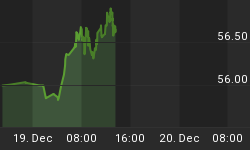In the past few days there has been a lot of discussion around the U.S. financial markets having caught up with pre-September 2008 highs, with almost euphoric statements by financial commentators along the lines of 'you ain't seen nothing yet'. While anything is possible, the mantra that most frequently I have heard preached is that the U.S. equity markets will see blue skies from here because:
-
valuations are low because price-earnings ratios are low; and,
-
there is a tremendous amount of cash 'on the sidelines' that is likely to come into the U.S. equity markets - with the result that demand will exceed supply and the markets will continue their upward merry ways.
A word of caution before you leap to the conclusion that the U.S. equity markets are virtually certain to go higher, and accordingly that is the place to be 'all in'.
First, I have said a number of times in this Newsletter that price-earnings ratios are a financial markets short-cut to get to 'fair market value', and that the market price of any stock can be expressed as the 'present value of all future expectations'. In simple terms, that typically means that a large percentage of the current market price of any stock is the present value of operating results expected to be generated in future years. Only this past Friday I wrote a commentary titled World Economy: The only certainty is uncertainty, where I quoted German CEO's who said they couldn't be confident in their own five-year forecasts. If you didn't read that commentary on Friday, you should read it now. It goes a long way to suggest heavy reliance today by financial markets followers on price-earnings ratios is wrongly placed as a proxy for much of anything.
Second, with respect to cash on the sidelines, everything I read and hear suggests that indeed is the case. However, those with cash out of the financial markets may be more loath to put it back into those markets in these uncertaintimes than 'financial market makers' would like to be the case.
Ultimately, it is long-term sustained economic growth, and importantly long-term sustained 'real' economic growth, that will drive the financial markets higher in a meaningful and lasting way. Economic growth in the developed countries is not expected to do very much but keep up with inflation rates of +/-2% in 2013.
Price-earnings ratios and economic growth (or lack thereof) are bedfellows,and it is important to at all times remember that.
Finally, one has to wonder how much of an impact and influence the U.S. Federal Reserve's quantitative easing policies (now running at a combined QE3 and QE4 at $85 billion per month) is having on the U.S. financial markets.
One also ought to carefully reflect on the degree to which the current U.S. financial markets are driven by high frequency algorithmic trading, as contrasted with 'by how much current U.S. equity market prices are being driven by investors who plan to buy and hold what they buy. I suspect very little of the latter.
I suggest you read The Fed's Presence In The Markets Is Pretty Clear, an article written by Lance Roberts of StreetTalkLive, published in the past few days. I have not met or talked to Mr. Roberts, but in recent weeks have read several articles he has written on and around the U.S. financial markets. He strikes me as both experienced and well-balanced - and certainly does not strike me as a 'market tout'.
Topical Reference: The Fed's Presence In The Markets Is Pretty Clear, from Business Insider, Lance Roberts (StreetTalk Live), January 25, 2013 - reading time 5 minutes, thinking time longer.















